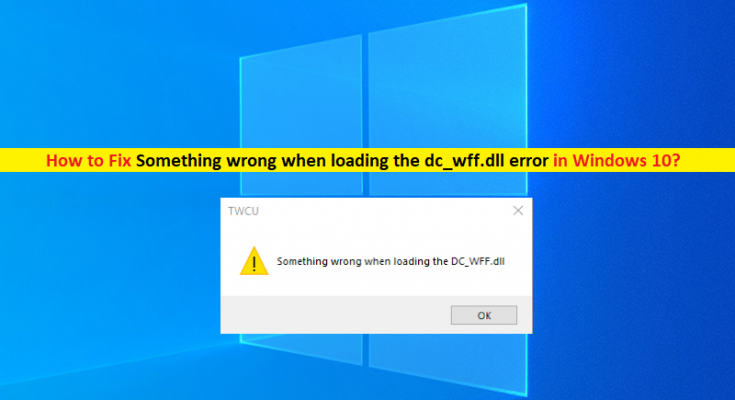What is ‘Something wrong when loading the dc_wff.dll’ error in Windows 10?
In this article, we are going to discuss on How to fix Something wrong when loading the dc_wff.dll error in Windows 10. You will be guided with easy steps/methods to resolve the error. Let’s starts the discussion.
‘Something wrong when loading the dc_wff.dll’ error: It is common Windows Problem considered as DLL error. This error is usually appeared when your start/restart your Windows computer after installing Windows Update. Several users reported about this error and explained they faced this DLL error on booting and every restart of computer.
There could be several reasons behind the issue including corrupting in system files or registry, issue with dc_wff.dll file, enabled TP-Link Wireless Configuration Utility, issue with TP-Link Application & driver, and other Windows 10 computer. Sometimes, this type of issue is occurred due to some temporary issues in your computer.
You can just restart your computer or perform power cycle your Windows computer in order to fix the issue, and after restart or power cycle operation is finished, please check if the error is resolved. It is possible to fix the issue with our instructions. Let’s go for the solution.
How to fix Something wrong when loading the dc_wff.dll error in Windows 10?
Method 1: Fix ‘Something wrong when loading the dc_wff.dll’ error with ‘PC Repair Tool’
‘PC Repair Tool’ is easy & quick way to find and fix BSOD errors, DLL errors, EXE errors, problems with programs/applications, malware or viruses issues, system files or registry issues and other system issues with just few clicks. You can get this tool through button/link below.
Method 2: Re-register dc_wff.dll file

Step 1: Type ‘cmd’ in ‘Windows Search Box’ and press ‘SHIFT + ENTER’ keys on keyboard to open ‘Command Prompt as Administrator’
Step 2: Type ‘regsvr32 /u dc_wff.dll’ command and hit ‘Enter’ key to execute in order to un-register the DLL file, and then execute ‘regsvr32 /I dc_wff.dll’ command in order to re-register the dc_wff.dll file.
Step 3: Once done, restart your computer and check if the error is resolved.
Method 3: Disable TP-Link Wireless Configuration Utility
Step 1: Open ‘Task Manager’ in Windows PC via Windows Search Box
Step 2: In ‘Task Manager’, click ‘Startup’ tab, find and right-click on ‘TP-Link Service’, and select ‘Disable’ to disable it. Once done, restart your computer and check if the error is resolved.
Method 4: Uninstall and then reinstall TP-Link application and driver
Step 1: Open ‘Control Panel’ in Windows PC via Windows Search Box and go to ‘Uninstall a Program > Programs & Features’
Step 2: Find and right-click on ‘TP-Link Wireless Configuration Utility’, and select ‘Uninstall’ to uninstall it. Once uninstalled, restart your computer and after restart, download and install device diver only and check if the error is resolved.
Download or reinstall Device Drivers update in Windows 10 [Automatically]
You can also try to update all Windows Drivers using Automatic Driver Update Tool. You can get this tool through button/link below.
Method 5: Perform Clean Boot operation

If the issue is still persist, then you can perform Clean Boot operation in computer in order to fix the issue.
Step 1: Open ‘System Configuration’ app in Windows PC via Windows Search Box
Step 2: In ‘System Configuration’ app, click ‘Services’ tab, tick ‘Hide all Microsoft Services’ checkbox and hit ‘Disable All’ button
Step 3: Now, click ‘Startup’ tab, and click ‘Open Task Manager’. In ‘Task Manager’, right-click on each startup item and select ‘Disable’ to disable them and once done, close ‘Task Manager’
Step 4: Finally, click ‘Apply’ and ‘Ok’ button in ‘System Configuration’ app to save the changes and then restart your computer, and check if the error is resolved.
Conclusion
I am sure this post helped you on How to fix Something wrong when loading the dc_wff.dll error in Windows 10 with several easy steps/methods. You can read & follow our instructions to do so. That’s all. For any suggestions or queries, please write on comment box below.



